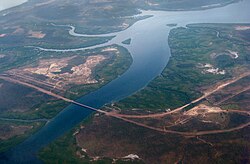Elizabeth River (Northern Territory)
| Elizabeth | |
|---|---|
 The Elizabeth River Bridge across Elizabeth River, upstream the East Arm of Darwin Harbour | |
Location of the Elizabeth River mouth in the Northern Territory | |
| Location | |
| Country | Australia |
| Territory | Northern Territory |
| Physical characteristics | |
| Source | |
| • location | Noonamah, Northern Territory, Australia |
| • elevation | 35 m (115 ft) |
| Mouth | |
• location | East Arm, Australia |
• coordinates | 12°32′31″S 130°58′55″E / 12.54194°S 130.98194°E |
• elevation | 0 m (0 ft) |
| Length | 28 km (17 mi) |
| [1] | |
Elizabeth River flows into Darwin Harbour close to Darwin in the Northern Territory of Australia.[2] It is a traditional waterway of the Larrakia people.[3]
Course
[edit]The headwaters of the river rise south of Noonamah and flow in a north westerly direction and cross the Stuart Highway south of Humpty Doo. It continues through an estuarine area and discharges into the East Arm of Darwin Harbour then Beagle Gulf and eventually into the Timor Sea.
The river shares a catchment area with the Finniss and Howard Rivers, the combined watershed occupies an area of 8,672 square kilometres (3,348 sq mi).[4]
Climate
[edit]The climate of the Elizabeth River region is monsoon tropical with two distinct seasons: dry and wet. The dry season lasts for six months between April and September with an average rainfall of 24 mm, whereas the wet season lasts between October and March with an average monthly rainfall of 254 mm/month (according to the Bureau of Meteorology, 1999). The majority of the rain falls between December and April. Runoff varies between 250–1000 mm.
Peak flow for the Elizabeth River occurs in February with 389Ml/day, after which it slowly decreases until July when there is no freshwater input into Darwin Harbour until the onset of the following wet season (Padovan 1997). Cyclone frequency is low to moderate.[2]
The Finniss, Elizabeth and Howard Rivers have a mean annual outflow of 3,000 gigalitres (3.924×109 cu yd),[5]
Water quality
[edit]The water quality at the upper estuary monitoring sites of the Northern Territory Government was 2011 in excellent condition. Water quality at the freshwater monitoring sites was in very good condition in 2011.[6]
Geology
[edit]The underlying lithology is dominated by Permian siltstones and sandstones.[2]
See also
[edit]References
[edit]- ^ "Map of Elizabeth River, NT". Bonzle Digital Atlas of Australia. Retrieved 25 May 2015.
- ^ a b c N Smit, R Billyard and L Ferns: Beagle Gulf Benthic Survey: Characterisation of soft substrates. Archived 28 March 2012 at the Wayback Machine Technical Report No. 66 (2000), Parks and Wildlife Commission of the Northern Territory.
- ^ "The Larrakia People". Larrakia Nation. 31 March 2023. Retrieved 1 December 2023.
- ^ "Drainage divisions" (PDF). Commonwealth of Australia. 2001. Archived from the original (PDF) on 1 April 2015. Retrieved 26 May 2015.
- ^ "Finniss/Elizabeth/Howard Rivers" (PDF). TRaCK. 2009. Retrieved 12 May 2015.
- ^ Elizabeth River and Estuary

